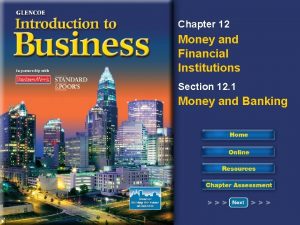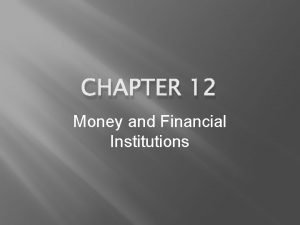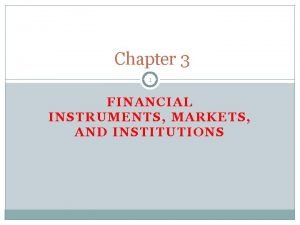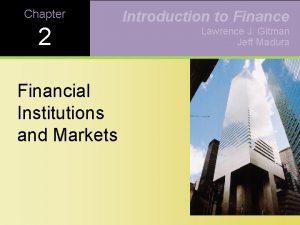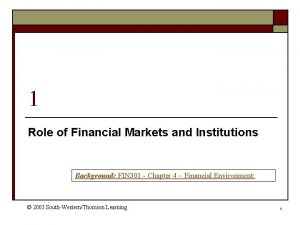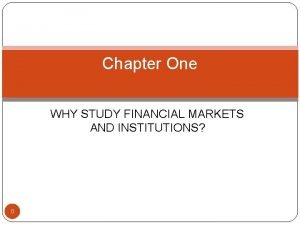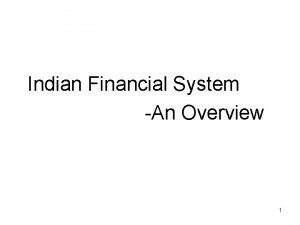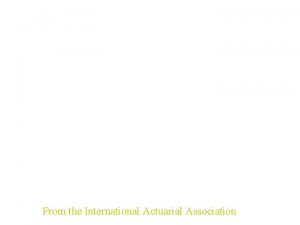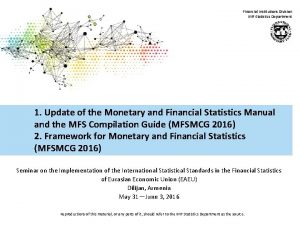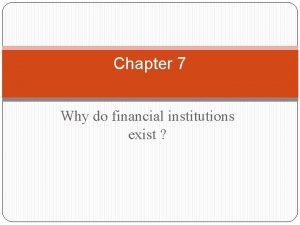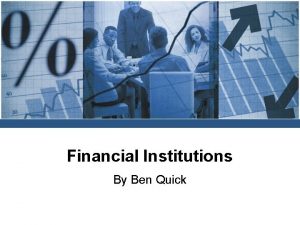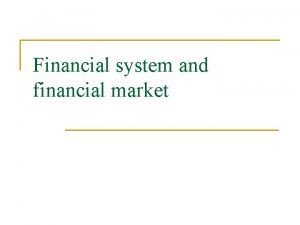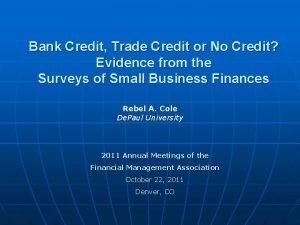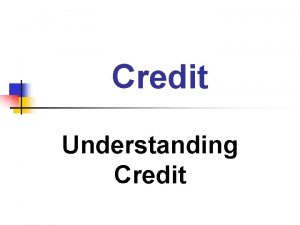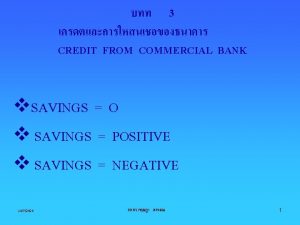Financial Institutions and Market ACFN 2 credit hour

























- Slides: 25

Financial Institutions and Market (ACFN, 2 credit hour) Debre Markos University College of Business and Economics Department of Accounting and Finance (PG-program)

Chapter one Overview of Financial System

Introduction • It is through a country’s financial system that entities with funds allocate those funds to those who have potentially more productive ways to deploy those funds, potentially leading to faster growth for a country’s economy. • A financial system makes possible a more efficient transfer of funds by overcoming the information asymmetry problem between those with funds to invest and those needing funds.

Cont’d • The financial system of an economy consists of three components: (1) financial markets; (2) financial intermediaries; and (3) financial regulators.

Definition of Financial system • Financial system is a system that aims at establishing and providing a regular, smooth, effective and efficient linkage between depositors and investors. • Financial system is a set of complex and closely connected instructions, agents, practices, markets, transactions, claims and liabilities relating to financial aspects of an economy. • Financial system is a system that comprises the interaction between financial institutions, financial market and participant in an attempt to transfer funds from severs to borrowers using financial instrument.

Features of Financial System Financial system provides an ideal linkage between depositors and investors. →It encourages savings and investment. Financial system facilitates expansion of financial markets over space and time. Financial system promotes efficient allocation of financial resources for socially desirable and economically productive purposes. Financial system influences both the quality and the pace of economic development.

Financial Concepts An understanding of the financial system requires an understanding of the following important concepts. Financial asset / financial instruments Financial intermediaries Financial market

1. Financial Assets • Financial assets are claims against the assets or resources of other economic units and are held as a store of value and for the return that is expected. A financial asset is a claim on a stream of income and/or a claim on a particular asset. The entity (or the economic unit) that offers the future cash flows is the issuer of the financial instrument; and the owner (holder) of the security is the investor.

Kinds/Classification of Financial Assets Ø Although the diverse kinds of securities created and/or issued whenever money is borrowed and lent in the financial system constitute what we call financial assets, there are three basic forms within which all of these instruments can be categorized. These are: 1. money 2. equity, and 3. debt securities.

Characteristics of Financial Assets Ø Ø Ø They are promises to future returns to their owners. They serve as a store of value/store of purchasing power. They cannot be depreciated or do not wear & tear over time. Moreover, their physical condition is not relevant in determining their market value.

Cont’d Ø Ø They are represented by a piece of paper that serves as a contract. They do have little and/or no value as a commodity. They do have low (or minimal) transport & storage costs relative to their value. They are fungible, that is, easily changed inform

Debt vs. Equity Instruments Ø A financial instrument can be classified by the type of claims that the investor has on the issuer. Ø A financial instrument in which the issuer agrees to pay the investor interest plus repay the amount borrowed is a debt instrument. Ø The interest payments that must be made by the issuer are fixed contractually. The key point is that the investor in a debt instrument can realize no more than the contractual amount. For this reason, debt instruments are often referred to as fixed income instruments.

Cont’d Ø In contrast to a debt obligation, an equity instrument specifies that the issuer pay the investor an amount based on earnings, if any, after the obligations that the issuer is required to make to investors of the firm’s debt instruments have been paid. Ø Some financial instruments fall into both categories in terms of their attributes. Preferred stock and convertible bonds are an example. These financial instruments have the characteristics of both debt and equity instrument.

Role of Financial Asset Financial assets serve two principal economic functions. 1. They allow the transference of funds from those entities who have surplus funds to invest to those who need funds to invest in tangible assets. 2. Risk diversification

Properties of Financial Assets 1. Moneyness 2. Divisibility and denomination 3. Reversibility 4. Cash flows and return predictability 5. Term of maturity 6. Convertibility 7. Currency 8. Liquidity 9. Complexity 10. Tax status

2. Financial Intermediaries • The term financial intermediary includes all kinds of organizations which intermediate and facilitate financial transactions of both individual and corporate customers. • Financial intermediaries obtain funds by issuing financial claims against themselves to market participants, then investing those funds.

Cont’d • Thus, it refers to all kinds of financial institutions and investing institutions, which facilitate financial transactions in financial markets. • Financial intermediaries include depository institutions, regulated investment companies, investment banks, and insurance companies.

Cont’d • The role of financial intermediaries is to create more favorable transaction terms than could be realized by lenders/investors and borrowers dealing directly with each other in the financial market. • This is accomplished by financial intermediaries in a two-step process: (1) obtaining funds from lenders or investors and (2) lending or investing the funds that they borrow to those who need funds.

Economic Functions of Financial Intermediaries Maturity intermediation Risk reduction via diversification Cost reduction for contracting and information processing Providing a Payments Mechanism

3. Financial Markets • A financial market is a market where financial instruments are exchanged. • A financial market is a market in which funds are transferred from people who have an excess of available funds to people who have a shortage. • They facilitate buying and selling of financial assets. • Financial markets such as bond and stock markets are crucial to promoting greater economic efficiency by channeling funds from people who do not have a productive use for them to those who do.

Cont’d Financial markets provide the following three major economic functions: Price discovery Liquidity Reduced transaction costs

Classification of financial markets 1. Classification by type of financial claim A. Equity (Stock) market B. Debt market 2. Classification by maturity of claim A. Money market B. Capital market 3. Classification by origin A. Primary Market B. Secondary Market 4. Classification by organizational structure A. Auction market B. Over the counter (OCT) market

Cont’d 5. Other Classifications A. Foreign exchange markets: which facilitate the trading of foreign exchange B. Insurance markets : which facilitate the redistribution of various risk C. Derivatives markets: which provide instruments for the management of financial risk (eg. Forward, future and options)

Functions of the Financial System There are seven basic functions of the financial system in modern society. These are: 1. 2. 3. 4. 5. 6. 7. Savings Function Wealth Function (store of value) Liquidity Function Credit Function Payments Function Risk Function; and Policy Function

Financial System and Economic Development Individual Assignment (10%) Select one article per group related to the role or relationship or influence of financial system on economic development and submit the revised article. Each group must include not more than three members. It should be submitted after two weeks
 Semester vs trimester
Semester vs trimester Why study financial institutions
Why study financial institutions Financial intermediaries ppt
Financial intermediaries ppt Financial institutions and markets lecture notes ppt
Financial institutions and markets lecture notes ppt Chapter 12 money and financial institutions
Chapter 12 money and financial institutions Chapter 12 money and financial institutions
Chapter 12 money and financial institutions Basic flow of funds through the financial system
Basic flow of funds through the financial system Madura j. financial markets and institutions
Madura j. financial markets and institutions Primary vs secondary financial markets
Primary vs secondary financial markets Madura j. financial markets and institutions
Madura j. financial markets and institutions Why study financial markets and institutions
Why study financial markets and institutions Bases of market segmentation
Bases of market segmentation 24 hour time to 12 hour time
24 hour time to 12 hour time Functions of financial institutions
Functions of financial institutions Management of financial institutions daibb pdf
Management of financial institutions daibb pdf Functions of financial system
Functions of financial system Types of financial institutions
Types of financial institutions Enterprise risk management for financial institutions
Enterprise risk management for financial institutions Louisiana office of financial institutions
Louisiana office of financial institutions Finanial institutions accounting
Finanial institutions accounting Financial literacy at minority serving institutions
Financial literacy at minority serving institutions What is financial institutions
What is financial institutions Financial institutions division
Financial institutions division Why do financial institutions exist
Why do financial institutions exist Leader follower challenger nicher
Leader follower challenger nicher Ung cost per credit hour
Ung cost per credit hour




